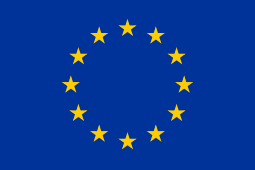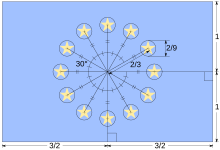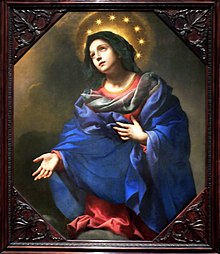Flag of Europe: Difference between revisions
Hemlock Martinis (talk | contribs) m Typo. |
|||
| Line 16: | Line 16: | ||
The '''Flag of Europe''' consists of a circle of twelve golden (yellow) stars on a blue background. It is most commonly associated with the [[European Union]] (EU), formerly the [[European Communities]], which adopted the flag in the 1980s. However it was first adopted by the [[Council of Europe]] (CoE), which created it in 1955. |
The '''Flag of Europe''' consists of a circle of twelve golden (yellow) stars on a blue background. It is most commonly associated with the [[European Union]] (EU), formerly the [[European Communities]], which adopted the flag in the 1980s. However it was first adopted by the [[Council of Europe]] (CoE), which created it in 1955. |
||
The EU and CoE are separate organisations; while the EU has 27 members, the CoE has 47 members and 5 |
The EU and CoE are separate organisations; while the EU has 27 members, the CoE has 47 members and 5 observers comprising not only all 27 EU members but also nearly all European countries except [[Belarus]], [[Kazakhstan]] and the [[Vatican City]]. When adopted by the CoE, it was to represent not just itself, but the whole of Europe. Since both the EU and the CoE work for [[European integration]], the two organisations are using the same flag. |
||
==History and usage== |
==History and usage== |
||
Revision as of 00:40, 23 September 2007
 | |
| Use | Civil and state flag, civil and state ensign |
|---|---|
| Proportion | 2:3 |
| Adopted | December 8, 1955 (CoE) May 26, 1986 (EU) |
| Design | A circle of 12 5-pointed gold stars on a blue field. |
| Designed by | Arsène Heitz |
The Flag of Europe consists of a circle of twelve golden (yellow) stars on a blue background. It is most commonly associated with the European Union (EU), formerly the European Communities, which adopted the flag in the 1980s. However it was first adopted by the Council of Europe (CoE), which created it in 1955.
The EU and CoE are separate organisations; while the EU has 27 members, the CoE has 47 members and 5 observers comprising not only all 27 EU members but also nearly all European countries except Belarus, Kazakhstan and the Vatican City. When adopted by the CoE, it was to represent not just itself, but the whole of Europe. Since both the EU and the CoE work for European integration, the two organisations are using the same flag.
History and usage
Previous flags

 Flag of the defunct ECSC
Flag of the defunct ECSCAlthough there have been numerous other flags developed by groups to represent Europe, the first major organisation to adopt one was the European Coal and Steel Community (ECSC). The ECSC which later merged into the European Communities. The ECSC was created in 1952 and the flag was unveiled in 1958 Expo in Brussels.[1]
The flag was two stripes, blue at the top, black at the bottom with 6 stars, 3 on each stripe. Blue was for steel, black for coal and the six stars were the six member-states. When the ECSC treaty expired in 2002, the flag was lowered in Brussels for the final time and replaced with the European flag.[1] The European Parliament also adopted its own flag. It followed the yellow and blue colour scheme however instead of 12 stars there were the letters EP and PE surrounded by wreath.[2]
Council of Europe
 The CoE now also uses a variant as its logo
The CoE now also uses a variant as its logoThe current European flag was originally adopted by the Council of Europe on December 8, 1955, from one of many designs attributed to Arsène Heitz.[3] On 25 October 1955 the Parliamentary Assembly of the Council of Europe (PACE) made the unanimous decision to adopt a circle of gold stars on a blue background as an emblem. On 8 December 1955 the Committee of Ministers adopted this as the European flag.[4] Even though the flag is most used by the EU, the Council of Europe owns the intellectual property of the flag. This means that the Secretary General of the Council of Europe could, in theory, bar the European Union from using the European flag.[citation needed]
The Council of Europe from the beginning desired it to be used by other regional organisations seeking European integration. However the Council now uses a defaced version of the flag as its emblem: it is the existing design with a stylised "e" over the stars (covering one, reducing the number to 11)[4] A derivative flag is also used by the Western European Union (WEU), a separate military alliance. Its flag is similar but has ten stars with the circle broken at the top. Inside were the letters WEU horizontally and UEO vertically, sharing the E in the centre.[5]
European Union
On 11 April 1983 the European Parliament became the first institution to adopt the flag, followed later by the European Community (EC) as a while on May 26, 1986. The European Union, which was established by the Maastricht Treaty in 1992 to replace the EC and encompass its functions, also adopted the flag. Since then the use of the flag has been controlled jointly by the Council of Europe and the European Union.[citation needed] The European Union also has a flag day, known as Europe Day on which the flag is often flow across the Union.[6][7]
The flag was to have been given a formal status in the European Constitution. However since the ratification of that failed, the leaders removed the state-like elements such as the flag from the replacement Reform Treaty. The European Parliament however had supported the inclusion of symbols and in response backed a proposal to use the symbols such as the flag more often in the Parliament with Jo Leinen MEP suggesting that the Parliament should again take the avant-garde in their use.[8]
While all other institutions and agencies adopted their own emblem, the European Commission, the Union's executive, only uses the flag to represent itself.[9] As part of the EU's usage, the flag appears on driving licences and licence plates issued in the bloc[10] as well as on the euro's banknotes and coins.[11]
The flag must also be used in every official speech made by the President-in-Office of the European Council and is often used on official visits to a non-EU country (where there is the flag of the third country, the national flag and European flag appear together). Some members also have their own rules regarding the use of the flag along side their national flag on domestic occasions. Outside official use, the flag may not be used for aims incompatible with European values.[10]
Wider use

The flag has been intended to represent Europe in its wider sense.[4] The Council of Europe covers all but three European countries, thereby representing much of Europe. In particular the flag has become a banner for pro-Europeanism outside the Union, for example in Georgia where the flag is on most government buildings since Mikhail Saakashvili came to power[12] who used it during his inauguration[13] stating: "[the European] flag is Georgia’s flag as well, as far as it embodies our civilisation, our culture, the essence of our history and perspective, and our vision for the future of Georgia."[14]
It is also used as a pro-democracy emblem in countries such as Belarus where it has been used on protest marches alongside the banned former national flag and flags of opposition movements.[15][16]
The flag is also used in certain sports arrangements where a unified 'Team Europe' is represented.
The features of the flag, or the flag in its entirety are often used as a parts of commercial brands or clearly reflected in the shaping of logos of Europe-wide organisations and companies.
Design
The flag is blue with a circle of 12 gold/yellow five-pointed stars orientated upwards (the number of stars is fixed). The Heraldic description given by the EU is: "On an azure field a circle of twelve golden mullets, their points not touching."[17]
The Council of Europe described the flag as: "Against the blue sky of the Western world, the stars represent the peoples of Europe in a circle, a symbol of unity. Their number shall be invariably set at twelve, the symbol of completeness and perfection ... just like the twelve signs of the zodiac represent the whole universe, the twelve gold stars stand for all peoples of Europe – including those who cannot as yet take part in building up Europe in unity and peace."

| Blue | Gold | |
|---|---|---|
| RGB | 0/51/153 |
255/204/0
|
| Hexadecimal | 003399 |
FFCC00
|
| Pantone | Reflex Blue | Yellow |
| CMYK | 100% Process Cyan, 80% Process Magenta | 100% Process Yellow |
Some claim that there was an early design of white stars on a light blue field, symbolising the dependence on the United Nations.[18]
Number of stars

The number of stars on the flag is fixed at 12 and is not related to the number of member states of the EU since it is originally the flag of the Council of Europe and does not have a relation with the EU. In 1953, the Council of Europe had 15 members; it was proposed that the future flag should have one star for each member, and would not change based on future members. West Germany objected to this as one of the members was the disputed area of Saarland, and to have its own star would imply sovereignty for the region. On this basis, France also objected to fourteen stars, as this would imply the absorption of Saarland into Germany. Myth has it that the Italian representative then objected that thirteen was an unlucky number (it is not unlucky in Italy, although seventeen is),[citation needed] as well as the fact that early flags of the United States featured that number of stars. Twelve was eventually adopted as a number with no political connotations and as a symbol of perfection and completeness[9] because of the ubiquity of the number for groups in European cultures and traditions such as:
|
Biblical interpretation

The circle of stars bears a striking similarity to the twelve-star halo of the Virgin Mary seen in Roman Catholic art. The flag's designer, Arsène Heitz, has acknowledged that the Book of Revelation (which is where the twelve-star halo of the Virgin Mary was first mentioned) helped to inspire him.[3] Apocalypse, Chapter 12:1, is cited to explain the symbolism: "A great sign appeared in heaven, a woman clothed with the sun, and the moon under her feet, and on her head a crown of twelve stars".
Others have traced the origin of the flag of Europe to the time of the Second World War. Paul M. G. Lévi, a Belgian of Jewish descent, vowed that he if he should survive the war, he would convert to Christianity. He duly survived and became a Catholic. On May 5 1949, the European Council was established in London and Paul Lévi became Chief of its Department of Culture. In 1952, when the idea of a European flag was being discussed, several proposed designs – perhaps inspired by the example several European national flags - included a cross; this however would have been rejected by the Socialists as ideologically biased and too Christian. One day Lévi passed a statue of the Virgin Mary with a halo of stars and was struck by the way the stars, reflecting the sun, glowed against the blue of the sky. Lévi later visited Count Benvenuti, a Venetian Christian democrat and then Secretary General of the European Council, and suggested that he should propose twelve golden stars on a blue ground as motif for the flag of Europe. This proposal became generally accepted.[19]
However, the official authorities of the European Union disregard the biblical interpretation as "myth".[20]
Alternative designs
Early proposals
 4 early proposals
4 early proposalsIn addition to official flags such as the ECSC flag, there were a number of alternative proposals for the European flag. These included using the flag of the International Paneuropean Union, which was a blue, with a red cross inside an orange circle at the centre. Due to the cross symbolism, this was rejected by Turkey (an early member of the Council of Europe).[18] Another organisation's flag was the European Movement, which had a large green E on a white background.[21][22]
A further design was one based on the Olympic rings; eight silver rings on a blue background. It was rejected due to the rings' similarity with "dial","chain" and "zeros". A proposal by Carl Weidl Raymon was of a large yellow star on a blue background. However it was rejected due to its similarity with the so-called Burnet flag, which had been briefly adopted in the 1830s by the Republic of Texas, and the flag of the Belgian Congo.[18]
Recent designs
In 2002, Dutch architect Rem Koolhaas and his architecture firm OMA designed a new flag in response to Commission President Romano Prodi's request to find ways of rebranding the Union in a way that represents Europe's "diversity and unity". The proposed new design was dubbed the "barcode" as it displays the colours of every European flag (of the then 15 members) as vertical stripes. As well as the barcode comparison, it had been compared unfavourably to wallpaper, a TV test card and deckchair fabric. Unlike the current flag it would change to reflect the member states.[23]
It was never officially adopted by the EU or any organisation however it was used as the logo of the Austrian EU Presidency in 2006. It had been updated with the colours of the 10 members who had joined since the proposal and was designed by Koolhaas's firm. Its described aim is "to portray Europe as the common effort of different nations, with each retaining its own unique cultural identity".[24]
See also
References
- ^ a b "The European Coal and Steel Community (ECSC)". Flags Of The World. 2004-10-28. Retrieved 2007-08-04.
{{cite web}}: Check date values in:|date=(help) - ^ European Parliament crwflags.com
- ^ a b "The European Commission and religious values". The Economist. 2004-10-28. Retrieved 2007-08-04.
{{cite web}}: Check date values in:|date=(help) - ^ a b c "Council of Europe's Emblems". Council of Europe. Retrieved 2007-08-16.
- ^ Western European Union crwflags.com
- ^ Rasmussen, Rina Valeur. "Celebration of Europe Day 9 May 2007 in Denmar". politeia. Retrieved 2007-08-04.
- ^ Rasmussen, Rina Valeur (2007-09-05). "London Eye lights up in colours of the European flag". Europa (web portal). Retrieved 2007-08-04.
{{cite web}}: Check date values in:|date=(help) - ^ Beunderman, Mark (2007-07-11). "MEPs defy member states on EU symbols". EU Observer. Retrieved 2007-07-12.
{{cite web}}: Check date values in:|date=(help) - ^ a b "The European Flag". Europa (web portal). Retrieved 2007-08-04.
- ^ a b "European Union: Legal use of the flag". Flags Of The World. 2004-10-28. Retrieved 2007-08-04.
{{cite web}}: Check date values in:|date=(help) - ^ "The euro". European Central Bank. Retrieved 2007-08-04.
- ^ "Comment - Georgia: Brussels on its mind". EU Observer. Retrieved 2007-05-01.
- ^ "Saakashvili Sworn In as New President". Templeton Thorp. Retrieved 2007-08-04.
- ^ "Georgia: Brussels on its mind". rferl.org. 2007-05-02. Retrieved 2007-08-25.
{{cite web}}: Check date values in:|date=(help) - ^ "Belarus: Scores Arrested, Opposition Leader Hospitalized After Minsk Protests". rferl.org. 2004-10-20. Retrieved 2007-08-04.
{{cite web}}: Check date values in:|date=(help) - ^ Myers, Steven Lee (2006-03-20). "Election is landslide for leader of Belarus". International Herald Tribune. Retrieved 2007-08-25.
{{cite web}}: Check date values in:|date=(help); Unknown parameter|otherauthors=ignored (help) - ^ "Graphical specifications for the European Emblem". Europa (web portal). Retrieved 2007-08-04.
- ^ a b c Council of Europe fahnenversand.de
- ^ The Flag and State Encyclopaedia
- ^ "European Union: Myths on the flag". Flags Of The World. 2007-02-04. Retrieved 2007-08-04.
{{cite web}}: Check date values in:|date=(help) - ^ European Movement crwflags.com
- ^ Proposals for the European flag crwflags.com
- ^ "Down with EU stars, run up stripes". BBC News. May 8, 2002.
- ^ Austrian EU Presidency Logo
External links
- Council of Europe on the European Flag
- Graphical specifications for the European Emblem
- Flag of the European Union European Navigator
- CIA page
- European Union at Flags of the World
- Memorandum on design and designer of European flag
- World flag database
